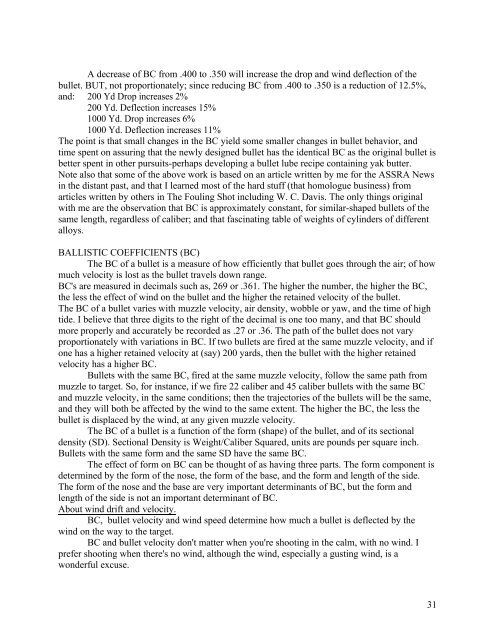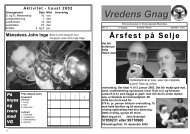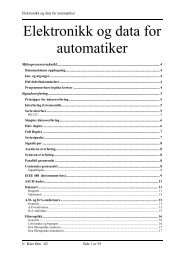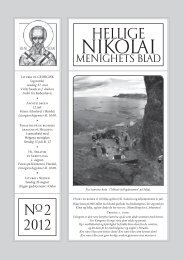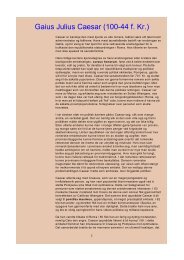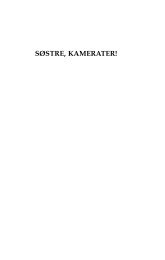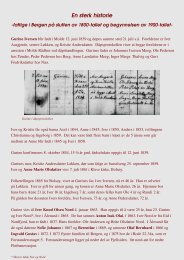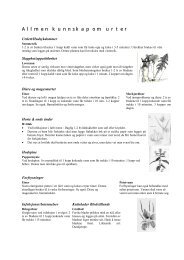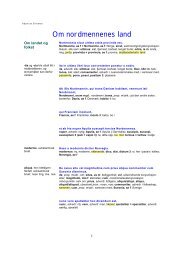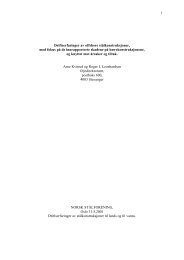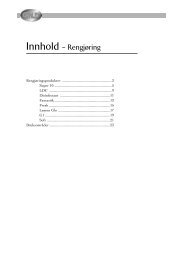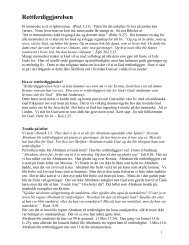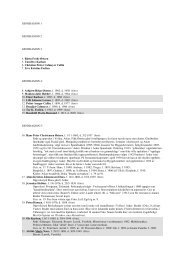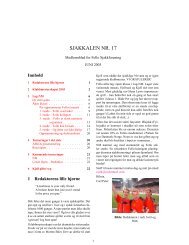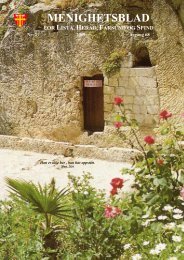- Page 1 and 2: 0.0 THE BEGINNING INTRODUCTION CAST
- Page 3 and 4: The contributors: Jason Adams Charl
- Page 5 and 6: TABLE OF CONTENTS 0.0 THE BEGINNING
- Page 7 and 8: WHEELWEIGHTS AND HEAT TREATING CAST
- Page 9 and 10: HOW TO DETERMINE “FIRST SHOT HIT
- Page 11 and 12: ALLOY CYLINDER WEIGHTS BY CALIBER A
- Page 13 and 14: 1.0 SAFETY BULLET CASTING SAFETY Th
- Page 15 and 16: Second, after you pick up each case
- Page 17 and 18: educe the pressures until the effec
- Page 19 and 20: Tapered bullets have bands that are
- Page 21 and 22: last band .315”. Bullet seated in
- Page 23 and 24: These are the hollow base and stand
- Page 25 and 26: The most important thing about slug
- Page 27 and 28: From Ken Mollohan: Joe, Pretty nice
- Page 29 and 30: 2.2 BULLET DESIGN AND FIT How To Sc
- Page 31: A .257" diameter, 1" long wheelweig
- Page 35 and 36: Here's the same data as a graph: He
- Page 37 and 38: I just have to study these tables a
- Page 39 and 40: Army. About 40% of the bullet is a
- Page 41 and 42: throat, reducing down at 1 degree a
- Page 43 and 44: to fit the chamber. The 387178 is a
- Page 45 and 46: it drops in of its own weight, it i
- Page 47 and 48: Over stabilization Let's take anoth
- Page 49 and 50: Repeat this several times until you
- Page 51 and 52: Lead bullets weigh (very) approxima
- Page 53 and 54: 1,000-yd line. A faster twist would
- Page 55 and 56: 3.2 BULLET CASTING METALS ACQUIRING
- Page 57 and 58: The addition of more than 10% tin t
- Page 59 and 60: Based on all of this data, I conclu
- Page 61 and 62: Bill McGraw: "Tin (Sn) has a specif
- Page 63 and 64: difference in percentage of tin or
- Page 65 and 66: So the mystery alloy has about 2% t
- Page 67 and 68: "Quickload" is a computer program t
- Page 69 and 70: These are the prescriptions for the
- Page 71 and 72: 38/55 160-31 Floyd 246 Rel 7 17 WW
- Page 73 and 74: (psi) which simplifies matching the
- Page 75 and 76: achieve some very high velocities w
- Page 77 and 78: 3.4 HOW TO CAST BULLETS Safety Melt
- Page 79 and 80: Bullet molds come in “nose pour
- Page 81 and 82: lasts just under two hours. I inspe
- Page 83 and 84:
Here's my setup for weighing bullet
- Page 85 and 86:
over and make a mess, but it doesn
- Page 87 and 88:
Filing the mold top. Filing chamfer
- Page 89 and 90:
Make sure the mold is adjusted acco
- Page 91 and 92:
A set of bullets had the bases file
- Page 93 and 94:
damaged = filed bases fly wildly to
- Page 95 and 96:
More damaged bullets To damage some
- Page 98 and 99:
tests: I repeated the tests on 5/23
- Page 100 and 101:
4.0 HOW TO MODIFY CAST BULLETS . Bu
- Page 102 and 103:
4) Even if bullets are slightly ell
- Page 104 and 105:
the handle joint trying to get them
- Page 106 and 107:
How many revolutions, or how long d
- Page 108 and 109:
If you want to enlarge a mold more
- Page 110 and 111:
out once on a RCBS 165 gr. Sil. bul
- Page 112 and 113:
ullets to fit his rifles, and set m
- Page 114 and 115:
I use the NUT; it fits inside the S
- Page 116 and 117:
4.2 GAS CHECKS Gas checks are small
- Page 118 and 119:
Tom Gray on CBA "My use of annealed
- Page 120 and 121:
"I use gas checks in my 44 Mags on
- Page 122 and 123:
4.3 Swaging Cast Bullets Norman F.
- Page 124 and 125:
The other meaning; that which Tom G
- Page 126 and 127:
Commercial .38 Caliber SWC Swaged t
- Page 128 and 129:
Swaging Flat Points From 250 Grain
- Page 130 and 131:
Illustration 3230 Grain FMJ Swaged
- Page 132 and 133:
local auto factory to be measured f
- Page 134 and 135:
The Lee Classic press will not swag
- Page 136 and 137:
4.4 PAPER-PATCHED BULLETS Ken Mollo
- Page 138 and 139:
A little digging through my bits ga
- Page 140 and 141:
use a Lyman M -die and Lyman seatin
- Page 142 and 143:
ody at groove diameter or slightly
- Page 144 and 145:
4.5 HEAT TREATING LEAD BULLETS HEAT
- Page 146 and 147:
method, I've produced bullets as ha
- Page 148 and 149:
Attached is a graph that I develope
- Page 150 and 151:
Colander Getting the bullets out of
- Page 152 and 153:
Does this matter? That depends on y
- Page 154 and 155:
There have been articles on heat tr
- Page 156 and 157:
I reviewed the test process several
- Page 158 and 159:
Those 34 bullets were then washed i
- Page 160 and 161:
many years ago. Part of it had 1% T
- Page 162 and 163:
the bullet. It’s limited to low v
- Page 164 and 165:
frying pan. When the lube melts, st
- Page 166 and 167:
Keep the heat as low as possible. T
- Page 168 and 169:
Lyman used to sell a device called
- Page 170 and 171:
50% Pure Natural Beeswax 40% Crisco
- Page 172 and 173:
The rifle is a Savage Tactical rifl
- Page 174 and 175:
etch droplets - and their surface t
- Page 176 and 177:
6.1 CAST BULLET RELOADING HOW TO AS
- Page 178 and 179:
ullet can be oriented with the head
- Page 180 and 181:
with my fingers before putting the
- Page 182 and 183:
olt will let me seat the bullet out
- Page 184 and 185:
.38/55 Winchester and Ballard, 375
- Page 186 and 187:
We are told that the energy and vel
- Page 188 and 189:
4. Use Lee die "O" rings between yo
- Page 190 and 191:
TARGET AND HUNTING AMMO, THE WAY I
- Page 192 and 193:
6.2 CARTRIDGE CASES HOW TO CARE FOR
- Page 194 and 195:
down to a smaller diameter, the way
- Page 196 and 197:
Being chicken, I trimmed the cases
- Page 198 and 199:
Oct. 6, '01 - 311403, - 20:1 - 8.3
- Page 200 and 201:
dropping it in water, will keep you
- Page 202 and 203:
I have checked chamber length in mi
- Page 204 and 205:
I still use plated 357 cases to ide
- Page 206 and 207:
As part of the case inspection proc
- Page 208 and 209:
come by: If you don't have a chemic
- Page 210 and 211:
6.3 PRIMERS AND PRIMING TOOLS Ameri
- Page 212 and 213:
most cases with the Lee Auto Prime,
- Page 214 and 215:
another by the force of the firing
- Page 216 and 217:
1) Fill Cases with Water 3) Lightly
- Page 218 and 219:
6.4 POWDERS AND POWDER MEASURES Use
- Page 220 and 221:
Second, this powder can be hard to
- Page 222 and 223:
THE ASTOUNDING POWDER MEASURE TEST!
- Page 224 and 225:
Dippers and repeatability Hoping th
- Page 226 and 227:
The Lee Perfect measure doesn't cru
- Page 228 and 229:
AA#9 14.5 grains 55 grains IM R4227
- Page 230 and 231:
The Chargemaster must be put on a s
- Page 232 and 233:
Yet other shooters use grease or lu
- Page 234 and 235:
If a person has a less than perfect
- Page 236 and 237:
I rechambered to .50-140, switched
- Page 238 and 239:
Did the chamber of the 30/30 or 30/
- Page 240 and 241:
6.6 HOW TO WORK UP AN ACCURATE RIFL
- Page 242 and 243:
a bullet that is properly fitted to
- Page 244 and 245:
For gas check bullets, the metal sh
- Page 246 and 247:
Powder A Powder B Powder C #1 Prime
- Page 248 and 249:
It seems pretty clear that variatio
- Page 250 and 251:
"I value my Pact I because it gives
- Page 252 and 253:
underlying average and we call it M
- Page 254 and 255:
Another way to look at the relation
- Page 256 and 257:
Here's a table showing the muzzle v
- Page 258 and 259:
no neck. To hold a bullet in the ca
- Page 260 and 261:
Sometimes the bullet will breech se
- Page 262 and 263:
Here are the cases from the side, s
- Page 264 and 265:
This photo shows the rifle barrel w
- Page 266 and 267:
The breech-muzzle loading technique
- Page 268 and 269:
6.6.3 RELOADING CAST LEAD BULLETS F
- Page 270 and 271:
When you slug your barrel, note if
- Page 272 and 273:
MORE ABOUT SHOOTING LEAD BULLETS IN
- Page 274 and 275:
for hand gunners are the semi-wadcu
- Page 276 and 277:
I now use BHN = 10 alloy ( 20:1 Pb:
- Page 278 and 279:
evolver. But, the effects of changi
- Page 280 and 281:
6.6.4 LOADING AND RELOADING WITH BL
- Page 282 and 283:
Cartridge firearms using black powd
- Page 284 and 285:
"I loaded up some loads and shot th
- Page 286 and 287:
Black powder cartridges "In a cartr
- Page 288 and 289:
Many shooters use a “blow tube”
- Page 290 and 291:
Another caveat is that this was all
- Page 292 and 293:
Roll a piece of wrapping paper abou
- Page 294 and 295:
Moisten entire front end of paper a
- Page 296 and 297:
Drop right in a 58 Remington. Colts
- Page 298 and 299:
It is claimed that 22 cast bullets
- Page 300 and 301:
My own experience shooting 22 cast
- Page 302 and 303:
6.7 ON HEADSPACE (Drawings courtesy
- Page 304 and 305:
Other cases headspacing on the shou
- Page 306 and 307:
Thanks to Paul Brasky for asking wh
- Page 308 and 309:
primer protrusion is equal to the e
- Page 310 and 311:
6.8 ON MOLY COATED BULLETS Jesse H.
- Page 312 and 313:
A Note on the Lee Collet Die by Joe
- Page 314 and 315:
In aiming the rifle (N.R.A. standin
- Page 316 and 317:
Good luck be with you." 315
- Page 318 and 319:
The rifle should be free to recoil
- Page 320 and 321:
I used this arrangement for many ye
- Page 322 and 323:
Here's the muzzle clamp with the wo
- Page 324 and 325:
7.3 SIGHTS Sights are either iron s
- Page 326 and 327:
glare on exposed sights. The tube k
- Page 328 and 329:
The Anschutz sight has clicks of .0
- Page 330 and 331:
HOW TO ADJUST A WINDGAUGE FRONT SIG
- Page 332 and 333:
is to file a little bit back on! Or
- Page 334 and 335:
emove parallax. I have a Simmons 4X
- Page 336 and 337:
In the ASSRA matches, I believe tha
- Page 338 and 339:
Test 1 "Effect Of Learning On Dispe
- Page 340 and 341:
7.4 ON ACCURACY Accuracy is the deg
- Page 342 and 343:
I propose the following procedure f
- Page 344 and 345:
Number Upper Lower Upper Lower of g
- Page 346 and 347:
were less than 1:2, most were much
- Page 348 and 349:
7.5 SPOTTING SCOPES Spotting Scopes
- Page 350 and 351:
7.6 SHOOTING IN MIRAGE AND WIND Win
- Page 352 and 353:
7.7 CANT (Cant in a handgun is not
- Page 354 and 355:
ig envelope held on with a rubber b
- Page 356 and 357:
those minimum shot/maximum shot par
- Page 358 and 359:
I have been shooting a CPA 32-40 cl
- Page 360 and 361:
After ten patches, if the next patc
- Page 362 and 363:
juice is turned on. The plan is to
- Page 364 and 365:
8.1 CAST BULLET ASSOCIATION MATCHES
- Page 366 and 367:
CBA PRODUCTION CLASS--John Alexande
- Page 368 and 369:
Barrels: Hart 6 Shilen 3 Lilja 3 St
- Page 370 and 371:
In Cast Bullet competition there is
- Page 372 and 373:
(b) Targets the original issued sto
- Page 374 and 375:
8.2 INTRODUCTION TO SCHUETZEN RIFLE
- Page 376 and 377:
8.3 BUFFALO RIFLE Forrest Asmus I l
- Page 378 and 379:
weight of course and such weight wi
- Page 380 and 381:
8.4 BLACK POWDER SHOOTING We're for
- Page 382 and 383:
in and soften the black powder foul
- Page 384 and 385:
8.5 HUNTING WITH CAST BULLETS HUNTI
- Page 386 and 387:
Boar hog taken with a pure lead .49
- Page 388 and 389:
Hog/deer double taken with a .308 a
- Page 390 and 391:
The wad (beeswax softened with enou
- Page 392 and 393:
further; otherwise, the HT-Q bullet
- Page 394 and 395:
deer's forequarter from this one ti
- Page 396 and 397:
priming charge which lights off the
- Page 398 and 399:
The rifle muzzle showing the alignm
- Page 400 and 401:
produce this size bullet diameter.
- Page 402 and 403:
Hodgdon brand Pyrodex and Triple Se
- Page 404 and 405:
USA 492-450 Bullet greaser for .451
- Page 406 and 407:
Some commonly used muzzleloading pr
- Page 408 and 409:
Full bore conicals should be lubed
- Page 410 and 411:
First is the single shot pistol wit
- Page 412 and 413:
military configuration. "F" grade i
- Page 414 and 415:
This is a photo of a Peabody Creedm
- Page 416 and 417:
many shooters share this opinion. M
- Page 418 and 419:
This action is similar to the 1885
- Page 420 and 421:
the time and money to have a rifle
- Page 422 and 423:
The earlier Mausers are legion. The
- Page 424 and 425:
configuration, available from Colt,


